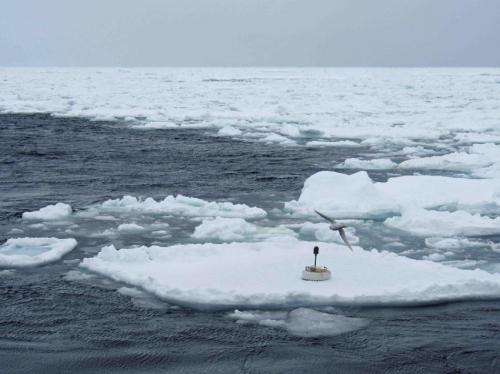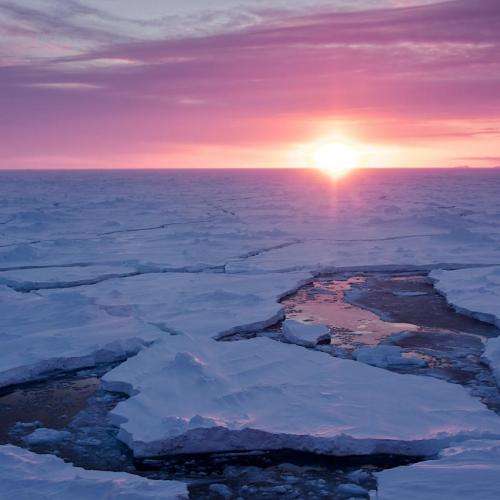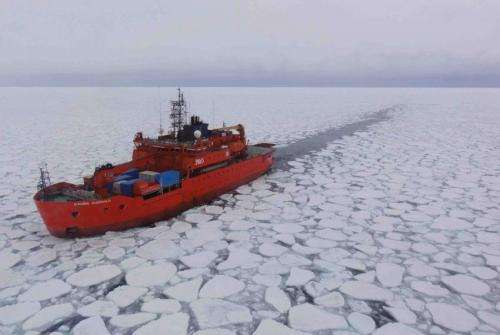Wave sensor on an ice floe shortly after deployment. Credit: Wendy Pyper
(Phys.org) —A small team of researchers from Australia and New Zealand has found that large waves caused by ocean storms appears to be playing a bigger role in breaking up polar sea ice than has been thought. In their paper published in the journal Nature, the team describes how they set up sensors to measure the impact of waves on sea ice and how their findings might help explain why sea ice is increasing in some parts of the world and decreasing in others.
Polar sea ice, the researchers note, is quite different from ice shelves—sea ice is ice that floats on the surface of the sea—ice shelves reside on land and sometimes slide slowly into the sea. Melting ice shelves, due to global warming are predicted to cause sea levels around the world to rise. Melting sea ice, on the other hand, doesn't cause a rise in sea levels, it's already in the water.
The amount of sea ice that exists and why it's located where it is has become a mystery to scientists as global warming has been having an impact on the planet. Instead of slowly melting away, sea ice has simply changed—in some places levels have fallen, while in many others, it's increased—a lot. To try to find out why this is, the researchers with this latest effort set up sensors to monitor what happens when waves strike the ice. The assumption has generally been that waves tend to work against the edges of sea ice. The sensor readings suggested otherwise, indicating that large wave strikes can cause ice to break a large distance from the edge. More specifically, they found that waves larger than 3 meters high caused breaks in the sea ice at variable distances from the edge, in some instances, causing chunks of ice to break away.
The sun setting over a field of broken sea ice. Credit: Rob Johnson
Expanding on their findings, the researchers set up computer models to describe what they'd found and discovered that large waves can actually cause large floes to fracture into many smaller ones. Smaller floes that travel into warmer water can obviously melt, causing a decrease in sea ice. Thus, the researchers note, an increase in the number and intensity of storms in the ocean, which can cause bigger waves, could be the driving force behind the difficult to predict changes in polar sea ice levels.
The Aurora Australis sailing through the marginal ice zone. Credit: Alison Kohout
More information: Storm-induced sea-ice breakup and the implications for ice extent, Nature 509, 604–607 (29 May 2014) DOI: 10.1038/nature13262
Abstract
The propagation of large, storm-generated waves through sea ice has so far not been measured, limiting our understanding of how ocean waves break sea ice. Without improved knowledge of ice breakup, we are unable to understand recent changes, or predict future changes, in Arctic and Antarctic sea ice. Here we show that storm-generated ocean waves propagating through Antarctic sea ice are able to transport enough energy to break sea ice hundreds of kilometres from the ice edge. Our results, which are based on concurrent observations at multiple locations, establish that large waves break sea ice much farther from the ice edge than would be predicted by the commonly assumed exponential decay. We observed the wave height decay to be almost linear for large waves—those with a significant wave height greater than three metres—and to be exponential only for small waves. This implies a more prominent role for large ocean waves in sea-ice breakup and retreat than previously thought. We examine the wider relevance of this by comparing observed Antarctic sea-ice edge positions with changes in modelled significant wave heights for the Southern Ocean between 1997 and 2009, and find that the retreat and expansion of the sea-ice edge correlate with mean significant wave height increases and decreases, respectively. This includes capturing the spatial variability in sea-ice trends found in the Ross and Amundsen–Bellingshausen seas. Climate models fail to capture recent changes in sea ice in both polar region. Our results suggest that the incorporation of explicit or parameterized interactions between ocean waves and sea ice may resolve this problem.
Journal information: Nature
© 2014 Phys.org
























